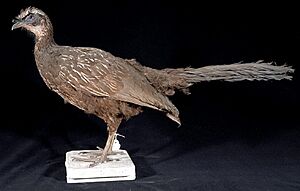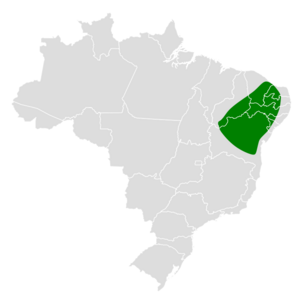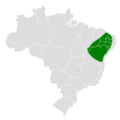White-browed guan facts for kids
Quick facts for kids White-browed guan |
|
|---|---|
 |
|
| Conservation status | |
| Scientific classification | |
| Genus: |
Penelope
|
| Species: |
jacucaca
|
 |
|
The white-browed guan (Penelope jacucaca) is a special type of bird. It belongs to a family of birds called chachalacas, guans, and curassows, known as Cracidae. This bird lives only in northeastern Brazil, which means it is endemic to that area.
Contents
About the White-Browed Guan
What Does It Look Like?
The white-browed guan is a medium-sized bird, about 65 to 70 cm (2.1 to 2.3 ft) long. It gets its name from a clear white stripe above its eye, which looks like an eyebrow. A thin black line separates this white stripe from the gray skin around its eye.
Most of its feathers are a dark blackish-brown. You can see bright white streaks on its upper wings. Like other guans, it has a red patch of skin under its chin, called a dewlap. Young guans, called juveniles, do not have this red dewlap. Their face skin is yellowish, and their white wing streaks are not as bright.
Where Does It Live?
You can find the white-browed guan in northeastern Brazil. Its home stretches from southern Maranhão to northeastern Minas Gerais, reaching all the way to the Atlantic coast.
This bird likes to live in dry forests. These include open angical forests, caatinga (a type of dry shrubland), and restinga (coastal forests). Sometimes, it can even be found in campo rupestre grasslands. It seems to be able to live even in places where its habitat has been slightly changed by humans. These birds live from sea level up to about 1,000 m (3,300 ft) high.
White-Browed Guan Behavior
How It Moves Around
Scientists have not studied much about how the white-browed guan moves. However, they believe it usually stays in one area. It probably only travels short distances to find food and water.
What Does It Eat?
White-browed guans usually look for food on the ground. They often feed in small groups, sometimes with up to seven birds together. We do not have a detailed list of everything they eat. But it is thought that their diet includes fruits, seeds, and insects. They also visit water sources to drink.
Reproduction and Life Cycle
The exact breeding season for the white-browed guan is not fully known. However, it seems to happen during at least part of the rainy season. These birds build their nests in trees or palm trees. They make the nest from sticks and line it with dry leaves. A female guan usually lays two or three eggs at a time.
Sounds and Calls
The white-browed guan can make a special sound by whirring its wings. This is similar to how other Penelope guans display. They also have several types of calls. These calls are described as "various honking" sounds, though some can be "raucous or grating."
Status and Conservation
The IUCN (International Union for Conservation of Nature) keeps track of how many white-browed guans there are. They first listed this bird as Threatened. But since 2004, they have changed its status to Vulnerable. This means the bird is still at risk, but not as much as before.
Even though these birds live in several protected areas, they are not found everywhere in their natural range. Their numbers have gone down because their homes are being destroyed and because of hunting. They have even disappeared from some areas completely.
Images for kids




